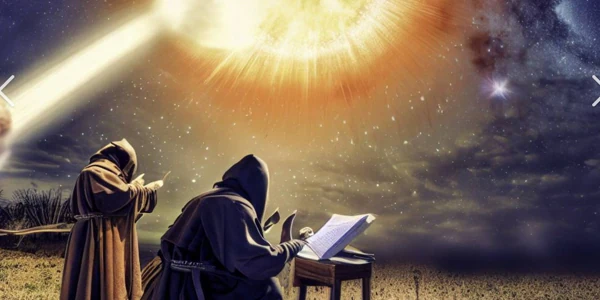In 1217, exactly 806 years ago, a German monk raised his eyes to the sky and noticed a normally faint star that shone with unusual intensity. The star continued to burn in this way for several days and Abbott Burchard, who at that time directed Ursberg Abbey, recorded the event in the chronicle of that year. “A wonderful sign was seen,” the monk wrote, adding that the mysterious object in the constellation of the Corona Borealis “shone with great light for many days.”
The medieval manuscript is the first available record of a rare space phenomenon called a ‘recurring nova’, a dead star that draws matter from a larger companion, ‘chokes’ on it and violently ejects them periodically, causing repeated flashes of light that They are repeated at regular intervals.
According to a study carried out by astronomer Bradley E. Shaefer, from Louisiana State University, and which can be consulted on the arXiv prepublication server, the ‘wonder star’ in question could be T CrB, in the constellation of the Corona Borealis, which dramatically increases its brightness for about a week every 80 years. Despite this, the phenomenon has only been scientifically documented twice: once in 1866 and once in 1946 (the star’s next explosion is expected in 2024).
In his article, Shaefer argues that both Bouchard’s record in 1217 and another chronicle from 1787 are, in fact, the first known sightings of the nova T CrB. But how to be sure of it? The monk, after all, could have witnessed some different phenomenon, such as a supernova or a comet. Something that Scheafer completely rules out since, as he writes in his article, if it had really been a supernova, one of the most violent events in the entire Universe, its remains would still be perfectly visible today, as is the case of the famous Crab Nebula, a supernova that exploded in the year 1074 and is perfectly distinguishable with most telescopes.
Neither supernova, nor comet
The possibility that the event was a comet, however, is a little more complicated to disprove. At the beginning of that year, indeed, a comet could be seen in the sky, according to a chronicle from the monastery of Saint Stephen in Greece. But most monks of the time were familiar with comets, which were considered dark omens of catastrophes and epidemics. So it’s unlikely that Burchard would have recorded a comet as something ‘wonderful’ or wouldn’t have mentioned its tail, Schaefer maintains.
As for the 1787 sighting, it was recorded by the English reverend and astronomer Francis Wollaston. And his story describes very nova-like behavior by a star whose coordinates match almost exactly the position of T CrB in the sky. While Wollaston identified the star using a name from the catalog of famous astronomer William Herschel, Schaefer believes its true identity is T CrB.
Either way, scientists will be prepared to witness the next nova burst, expected in late 2024. And when it arrives, they will add the event to a list of past records that is centuries old. Meanwhile, of course, they will continue to investigate old archives to study the history of T CrB. Hopefully, such activity will allow them to make more accurate predictions about the star’s behavior in the future.
